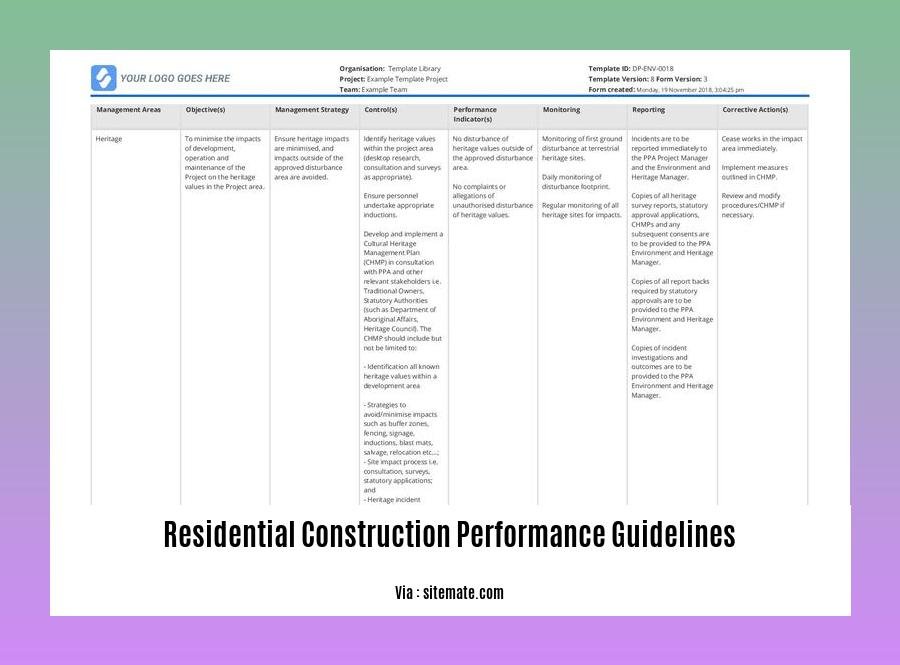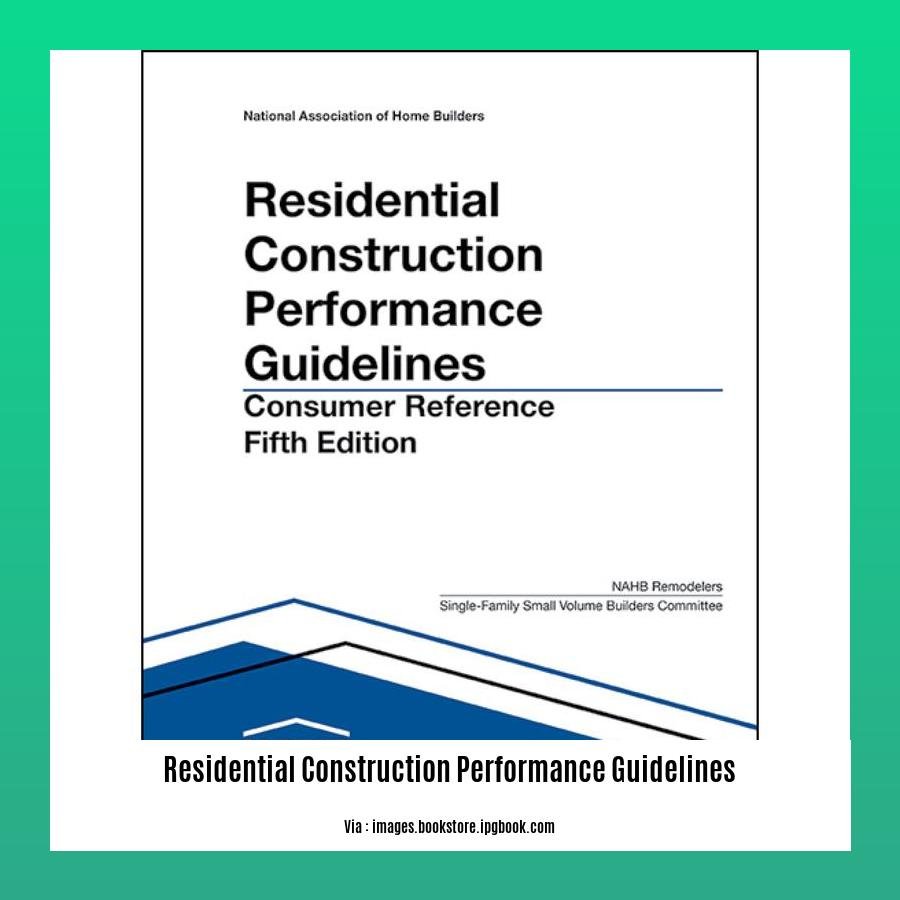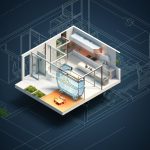Introducing the Residential Construction Performance Guidelines: A comprehensive framework to elevate the quality and efficiency of residential construction. This article delves into the significance of establishing industry guidelines that set high standards for building performance. It explores the crucial role these guidelines play in ensuring that homes are built to last, are energy-efficient, and meet the evolving needs of homeowners.
Key Takeaways:
- RCPG provides optional performance guidance for residential construction.
- Over 340 guidelines cover 13 construction categories.
- Builders can use RCPG to manage expectations, resolve complaints, and deliver high-quality homes.
- A consumer version helps homeowners understand home construction and performance standards.
- NAHB disclaims responsibility for inaccuracies or damages related to RCPG use.
Residential Construction Performance Guidelines: A Guide

What are Residential Construction Performance Guidelines (RCPGs)
RCPGs are a set of voluntary standards that help ensure the quality and performance of newly constructed homes. They cover a wide range of topics, such as structural integrity, energy efficiency, and indoor air quality.
Why are RCPGs Important for Homeowners?
RCPGs help homeowners make informed decisions about the construction of their new homes. They provide clear expectations for what the finished product should look like and how it should perform. This can help avoid costly repairs and disputes down the road.
How Can I Use RCPGs as a Builder?
RCPGs can be used by builders to:
- Manage customer expectations
- Resolve customer complaints
- Deliver high-performance homes
What are the Benefits of Using RCPGs?
There are many benefits to using RCPGs, including:
- Reduced risk of construction defects
- Increased customer satisfaction
- Improved energy efficiency
- Enhanced indoor air quality
How can I Get Started Using RCPGs?
RCPGs are available for purchase from the National Association of Home Builders (NAHB). Once you have purchased the guidelines, you can begin using them immediately.
Conclusion
RCPGs are a valuable tool for both homeowners and builders. They can help ensure that new homes are built to a high standard of quality and performance.
Are you planning to build a house? Learn some crucial house construction terms to help you understand the process better. If you need guidance, check out our comprehensive house construction tips to ensure a smooth and successful build. Looking for a new home in Toronto? Explore our exclusive listings of new construction homes in Toronto to find your dream abode. For your plumbing needs, connect with our trusted new construction plumbing companies who specialize in installing and maintaining plumbing systems in newly built homes.
Challenges in Implementing Performance Guidelines
Despite the benefits, implementing performance guidelines in residential construction faces some challenges:
- Cost implications: Adherence to performance guidelines may increase construction expenses, particularly for builders who lack experience or familiarity with sustainable practices.
- Lack of awareness: Not all stakeholders, including homeowners, builders, and architects, are fully aware of the guidelines and their significance.
- Limited resources: Small and medium-sized builders may face resource constraints that hinder their ability to implement performance guidelines effectively.
- Insufficient verification mechanisms: Establishing a robust system to verify compliance with performance standards remains a challenge, leading to potential inconsistency in implementation.
- Industry resistance: Some builders may resist adopting performance guidelines due to perceived impacts on their existing practices or fears about increased liability.
Key Takeaways:
- Performance guidelines provide clear standards but implementation faces challenges such as costs, awareness, and resources.
- Overcoming these challenges requires collaboration, outreach, and effective verification mechanisms.
- Embracing performance guidelines ultimately benefits homeowners, builders, and the industry as a whole by enhancing quality and efficiency.
Citation: NAHB Releases New Edition of Residential Construction Performance Guidelines
Strategies for Successful Implementation

The Residential Construction Performance Guidelines (RCPG) provide a solid foundation for improving the quality and efficiency of residential construction. Successful implementation requires a proactive approach, engaging all stakeholders in the building process. Here’s a practical guide to ensure effective implementation:
Key Takeaways:
- Establish Clear Communication: Foster open communication among homeowners, builders, architects, and inspectors to align expectations and minimize misunderstandings.
- Set Realistic Goals: Identify achievable performance targets that balance quality, cost, and time constraints.
- Incorporate Quality Control Measures: Implement rigorous inspections and testing throughout the construction process to identify and rectify potential issues early on.
- Educate and Train Professionals: Enhance knowledge and skills of construction professionals through comprehensive training on RCPG requirements.
- Encourage Collaboration and Partnerships: Foster partnerships between builders, suppliers, and industry organizations to share best practices and promote innovation.
Steps for Successful Implementation:
- Adopt RCPG Standards: Encourage widespread adoption of the RCPG as the benchmark for residential construction performance.
- Integrate into Contracts: Incorporate RCPG requirements into building contracts to ensure adherence throughout the project.
- Establish Inspection Protocols: Develop clear inspection protocols to verify compliance with RCPG standards at key construction stages.
- Provide Training and Education: Offer training and educational resources to contractors, architects, and inspectors to enhance their knowledge and skills.
- Monitor and Evaluate: Regularly monitor implementation progress and collect feedback to identify areas for improvement and ensure continuous compliance.
Benefits of Successful Implementation:
- Enhanced quality and durability of residential construction
- Reduced construction defects and associated costs
- Improved energy efficiency and reduced operating expenses
- Increased homeowner satisfaction and confidence
- Strengthened credibility of the residential construction industry
Relevant URL Source:
NAHB Releases New Edition of Residential Construction Performance Guidelines
Measuring and Evaluating Outcomes: A Key Pillar for Enhancing Construction Quality
When constructing a home, measuring and evaluating outcomes is crucial to ensure the highest performance. The recently updated Residential Construction Performance Guidelines (RCPG) set forth by the National Association of Home Builders (NAHB) provide a comprehensive framework for measuring and evaluating outcomes in residential construction.
Why Measure and Evaluate Outcomes?
- Identifies areas for improvement, leading to increased quality and efficiency.
- Provides homeowners with confidence and peace of mind in their investment.
- Facilitates effective communication between builders and homeowners, ensuring expectations are met.
Steps for Effective Measurement and Evaluation
- Establish Clear Performance Metrics: Define specific criteria to measure against, such as energy efficiency, durability, and functionality.
- Collect and Analyze Data: Gather relevant data through inspections, surveys, and monitoring systems to track performance.
- Interpret Results: Analyze data to identify trends, strengths, and weaknesses in construction practices.
- Implement Corrective Actions: Based on the analysis, identify necessary improvements to enhance performance.
- Monitor and Evaluate Progress: Track improvements over time and adjust strategies as needed to maintain and improve performance.
Key Takeaways:
- RCPG provides comprehensive guidelines for measuring and evaluating outcomes in residential construction.
- Effective measurement and evaluation leads to improved quality, efficiency, and homeowner satisfaction.
- Data analysis and interpretation are crucial for identifying areas for improvement.
- Implementing corrective actions ensures continuous improvement in construction processes.
- Monitoring and evaluation provide ongoing assurance of performance.
Relevant URL Sources:
- National Association of Home Builders (NAHB): Residential Construction Performance Guidelines
FAQ
Q1: What are the key advantages of using Residential Construction Performance Guidelines (RCPG)?
Q2: How can RCPG help homeowners understand and evaluate the performance of their homes?
Q3: Are RCPG mandatory for residential construction projects?
Q4: What are the key updates and improvements in the latest edition of RCPG?
Q5: Besides the NAHB RCPG, are there any other notable residential construction performance guidelines?
- Gray Kitchen Backsplash Tile: Ideas for a Stylish Upgrade - December 14, 2025
- Backsplash For Gray Cabinets: Choosing the Right Backsplash Style - December 13, 2025
- Gray And White Backsplash: Ideas For Timeless Style - December 12, 2025









